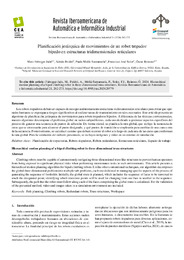Please use this identifier to cite or link to this item:
https://hdl.handle.net/11000/32890Full metadata record
| DC Field | Value | Language |
|---|---|---|
| dc.contributor.author | Fabregat Jaen, Marc | - |
| dc.contributor.author | Peidró, Adrián | - |
| dc.contributor.author | Mollá Santamaría, Paula | - |
| dc.contributor.author | Soler Mora, Francisco Jose | - |
| dc.contributor.author | Reinoso, Oscar | - |
| dc.contributor.other | Departamentos de la UMH::Ingeniería de Sistemas y Automática | es_ES |
| dc.date.accessioned | 2024-09-02T10:17:51Z | - |
| dc.date.available | 2024-09-02T10:17:51Z | - |
| dc.date.created | 2024 | - |
| dc.identifier.citation | Revista Iberoamericana de Automática e Informática Industrial (RIAI) 21 (2024) 262-273 | es_ES |
| dc.identifier.issn | 1697-7920 | - |
| dc.identifier.uri | https://hdl.handle.net/11000/32890 | - |
| dc.description.abstract | Los robots trepadores deben ser capaces de navegar autónomamente estructuras tridimensionales reticulares para evitar que operarios humanos se expongan a riesgos significativos al realizar tareas de mantenimiento en tales escenarios. Este artículo presenta un algoritmo de planificación jerárquica de movimientos para robots trepadores bípedos. A diferencia de las técnicas convencionales, nuestro algoritmo descompone el problema global en varios subproblemas, cada uno dedicado a gestionar aspectos específicos del proceso de generar una secuencia de puntos de adhesión. De forma inicial, se planifica la ruta global, que incluye la secuencia de caras que se atravesar´an para alcanzar el punto designado, y qu´e puntos de transici´on se emplear´an para cambiar de una cara a otra de la secuencia. Posteriormente, se calcula el camino que deberá recorrer el robot a lo largo de cada una de las caras que conforman la ruta global. Para la validación del m´etodo presentado, se incluyen imágenes y vídeo en un entorno de simulación. | es_ES |
| dc.description.abstract | Climbing robots must be capable of autonomously navigating three-dimensional truss-like structures to prevent human operators from being exposed to significant physical risks when performing maintenance tasks in such environments. This article presents a hierarchical motion planning algorithm for biped climbing robots. Unlike other conventional techniques, our algorithm decomposes the global three-dimensional problem into multiple sub-problems, each one dedicated to managing specific aspects of the process of generating the sequence of footholds. Initially, the global route is planned, which includes the sequence of faces to be traversed to reach the designated point, identifying which transition points will be used for changing from one face to another in the sequence. Subsequently, the path that the robot must follow along each of the faces comprising the global route is calculated. For the validation of the presented method, video and images taken in a simulation environment are included. | es_ES |
| dc.format | application/pdf | es_ES |
| dc.format.extent | 12 | es_ES |
| dc.language.iso | spa | es_ES |
| dc.publisher | Universidad Politécnica de Valencia | es_ES |
| dc.rights | info:eu-repo/semantics/openAccess | es_ES |
| dc.rights | Attribution-NonCommercial-NoDerivatives 4.0 Internacional | * |
| dc.rights.uri | http://creativecommons.org/licenses/by-nc-nd/4.0/ | * |
| dc.subject | planificación de trayectorias | es_ES |
| dc.subject | robots trepadores | es_ES |
| dc.subject | robots redundantes | es_ES |
| dc.subject | estructuras reticulares | es_ES |
| dc.subject | espacio de trabajo | es_ES |
| dc.subject.other | CDU::6 - Ciencias aplicadas::62 - Ingeniería. Tecnología | es_ES |
| dc.title | Planificación jerárquica de movimientos de un robot trepador bípedo en estructuras tridimensionales reticulares | es_ES |
| dc.type | info:eu-repo/semantics/article | es_ES |
| dc.relation.publisherversion | https://doi.org/10.4995/riai.2024.20779 | es_ES |

View/Open:
262-273-20779-ED.pdf
4,57 MB
Adobe PDF
Share:
.png)
